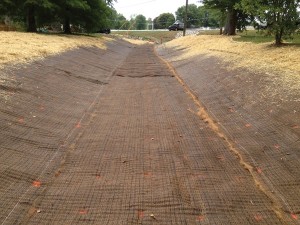Whether as part of construction efforts or to preserve property, erosion control methods are often needed for slope stabilization when surface water erodes layers of soil. There are various methods of erosion control available. One of the more popular methods is erosion control blankets. Kelly Sutton and Ryan Williams of the University of Washington put together a paper explaining the various types of erosion control blankets. Here’s a look at a few varieties as well as their methods of installation.
- Jute Netting
This netting can be used as part of a larger erosion control effort to hold together other materials used alone. It’s made from natural fiber jute, which is a long vegetable fiber used to make coarse threads.
- Fabrijute Netting
Rather than using natural fiber jute, fabrijute netting is made from plastic. It’s uses, however, as the same as natural jute netting.
- Straw Single Synthetic
As the name suggests, straw single synthetic netting is made from straw and held together by a synthetic layer of netting.
- Straw Double Jute
This netting is also made from straw, but rather than a single synthetic layer to hold it together, a double layer of natural jute threads is used.
- Straw Double Synthetic
Once again, this is an ordinary straw netting. To hold it together, a double layer of synthetic material is used.
- Coir Double Jute Blanket
Coconut fiber is another common material used for erosion control blankets. In this variety, a double layer of jute netting is used to hold the coconut fiber together.
- Coir Double Synthetic Blanket
Again, coconut fiber is used and held together by a double layer of synthetic netting.
- Excelsior Blanket
This blanket is alternatively known as an Aspen Fiber blanket because it’s made primarily from shredded Aspen trees. Those fibers are held together by a single plastic net.
- Excelsior Double Synthetic
Again, fibers from shredded Aspens are used, but in this variety, a double layer of synthetic netting is used to hold them together.
- Installation
Not only are erosion control blankets extremely useful to slow or stop the erosion of soil, they’re also relatively easy to install. The idea is to ensure that surface water moves over the top of the blanket, so you’ll want to start by digging a small trench in the top of the slope. This is also known as ‘keying’ the blanket into the slope. Lay the top end of the blanket into the trench and secure using staples. With your trench lined, you can fill it with soil.
At Maxwell Supply in Tulsa, we carry all the erosion control blankets and products you need. Browse through our inventory online, or give us a call at 918-836-8606.
